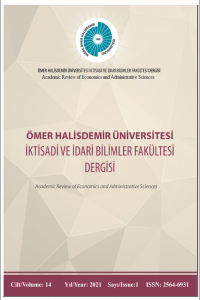Performans esaslı bütçe sisteminden program bazlı performans bütçe sistemine geçiş: yeni bütçe sistemi ile hedeflenenler
Abstract
Kamu bütçesi devletin en vazgeçilmez mali araçlarından biridir. Bu mali araç gerektiğinde maliye politikasının yönlendirilmesinde ve devletin asli fonksiyonu olan kamusal malların temininde, gerektiğinde de sosyal politikalar ve transfer ödemeleri ile vatandaşların refahını arttırılmasında kullanılır. Kamu bütçelerini özel bütçelerden farklı kılan onun yasa hükmünde olma özelliğidir. Sadece kendisinin yasa hükmünde olmasından ayrı, bütçenim düzenlenme ve uygulanma esasları da yasalarla düzenlenmiştir. Ancak tüm bunların dışında kamu bütçeleri teknik belgelerdir ve bu belgelerin belirli bir sistem içinde hazırlanması gerekir. Bütçe sistemleri birçok ülkede tarihsel süreç içerisinde revize edilmiş yeni bütçe sistemleri devreye sokulmuştur. Çok uzun bir dönem boyunca hâkim iktisadi düşünce olan Klasik İktisadi Düşünce Sistemi’nin temel felsefelerini benimseyen Klasik(Geleneksel) bütçe sisteminden günümüzde en yaygın olarak uygulanan program bütçe sistemine kadar birçok bütçe sistemi kamu mali yönetiminde yer almıştır. Ülkemizde çok uzun yıllar boyunca uygulanan Klasik(Geleneksel) Bütçe Sistemi’nden 1973 yılında Program Bütçe Sistemine geçilmiş ancak çok başarılı bir uygulama süreci gerçekleşmemiştir. 2003 yılında kabul edilen 5018 sayılı KMYKK ile Performans Esaslı Bütçe sistemi uygulanmaya başlamıştır. 2021 yılından itibaren de cari bütçe sistemi terk edilerek yerine yeni bir bütçe sistemi uygulamaya konulacaktır. Bu bağlamda makalemizde geçmişten günümüze bütçe sistemleri incelenerek yeni bütçe sistemimizin temel nitelikleri ve bu bütçe sisteminden beklentiler analiz edilmeye çalışılacaktır.
References
- Acar, İ. (1997). “Genellik – Birlik ilkesinden sapmalar ve katma bütçeli idareler”, Maliye Yazıları Dergisi, Sayı 57, 49-64.
- Batırel, Ö.F. (1981) Kamu Bütçesi, İ.İ.T.İ.A. Nihad Sayar – Yayın ve Yardım Vakfı Yayınları No: 352/585. İstanbul.
- Beynam, H. (2013). Türkiye'de performans esaslı bütçeleme uygulamasının etkinleştirilmesi: sivil havacılık genel müdürlüğü örneği (Yüksek Lisans Tezi). Hacettepe Üniversitesi, Sosyal Bilimler Enstitüsü , Ankara.
- BÜMKO, (2017). “Program yapısı ve program gerekçesi rehberi” Taslak, II. Sürüm,2017 , Maliye Bakanlığı, Ankara.
- Coşar, N. (2004). Kriz, savaş ve bütçe politikasının oluşumu (1926 – 1950), Bağlam Yayınları, İstanbul, 16 – 24.
- Çetin, S. (2010), “Türkiye’de kamu yönetimi reformu sürecinin değerlendirilmesi: aksayan ve işleyen yönler” Ç.Ü Sosyal Bilimler Enstitüsü Dergisi, Cilt:19, sayı:3, SF:23-38, 2010.
Transition from the performance-based budget system to the program based performance budget system: targeted with the new budget system
Abstract
The public budget is one of the most indispensable financial instruments of the state. This financial instrument is used to direct the fiscal policy when necessary and to provide public goods, which are the primary function of the state, and to increase the welfare of the citizens with social policies and transfer payments in need. The essence, which makes public budgets differ from private budgets, is its legal feature. In addition to the legality of public budget, the principles of regulation and implementation of the budget are also regulated by law. Nonetheless, apart from all these, capital budgets are considered as technical documents, and these documents should be prepared within a certain system. Budget systems have been revised through the historical process in many countries and new budget systems have being introduced. From the classical budget system, which adopted the basic philosophies of the Classical Economic Thought System and is the dominant economic notion for a very long period, to the Program budgeting system, which is the most widely applied program, many budget systems have taken part in public financial management. In 1973, The Classic Budget System, which was implemented in our country for many years, was replaced by the Program Budgeting System, but a successful implementation process could not manage. In 2003 latter, the event of adoption of the KMYKK numbered 5018, the Performance-Based Budget system has started to be implemented. As of 2021, the current budget system will be abandoned, and a new budget system will be implemented. In this context, we will try to analyze the basic features of our new budget system and expectations from this budget system by examining the budget systems from past to present in our article.
References
- Acar, İ. (1997). “Genellik – Birlik ilkesinden sapmalar ve katma bütçeli idareler”, Maliye Yazıları Dergisi, Sayı 57, 49-64.
- Batırel, Ö.F. (1981) Kamu Bütçesi, İ.İ.T.İ.A. Nihad Sayar – Yayın ve Yardım Vakfı Yayınları No: 352/585. İstanbul.
- Beynam, H. (2013). Türkiye'de performans esaslı bütçeleme uygulamasının etkinleştirilmesi: sivil havacılık genel müdürlüğü örneği (Yüksek Lisans Tezi). Hacettepe Üniversitesi, Sosyal Bilimler Enstitüsü , Ankara.
- BÜMKO, (2017). “Program yapısı ve program gerekçesi rehberi” Taslak, II. Sürüm,2017 , Maliye Bakanlığı, Ankara.
- Coşar, N. (2004). Kriz, savaş ve bütçe politikasının oluşumu (1926 – 1950), Bağlam Yayınları, İstanbul, 16 – 24.
- Çetin, S. (2010), “Türkiye’de kamu yönetimi reformu sürecinin değerlendirilmesi: aksayan ve işleyen yönler” Ç.Ü Sosyal Bilimler Enstitüsü Dergisi, Cilt:19, sayı:3, SF:23-38, 2010.
Details
| Primary Language | Turkish |
|---|---|
| Journal Section | Articles |
| Authors | |
| Publication Date | January 8, 2021 |
| Submission Date | August 10, 2020 |
| Acceptance Date | August 11, 2020 |
| Published in Issue | Year 2021 Volume: 14 Issue: 1 |
Cited By
Estimating of Health Services Expenditures within the Framework of Public Financial Management Using ARIMA Method
Journal of International Health Sciences and Management
https://doi.org/10.48121/jihsam.1400530
Türkiye’de cumhuriyet dönemi bütçe sistemlerinin gelişimi
Balıkesir Üniversitesi Sosyal Bilimler Enstitüsü Dergisi
https://doi.org/10.31795/baunsobed.1353396
Türkiye’de Mali Reform Kapsamında Performans Esaslı Program Bütçeye Geçiş Süreci
Anadolu Üniversitesi İktisadi ve İdari Bilimler Fakültesi Dergisi
Taner ERCAN
https://doi.org/10.53443/anadoluibfd.949215

Ömer Halisdemir Universitesi Iktisadi ve Idari Bilimler Fakültesi Dergisi (OHUIIBF) is licensed under the Creative Commons Attribution-Noncommercial-Pseudonymity License 4.0 international license.


